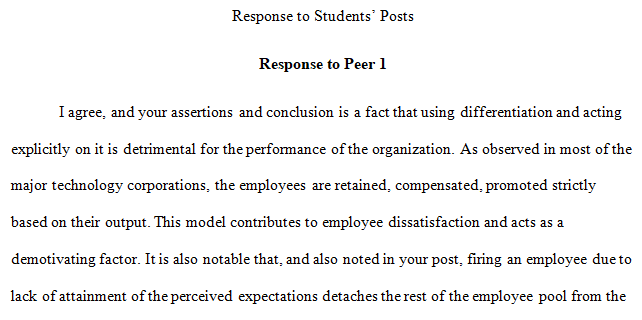
Use the Wall Street Journal menu link to find an article related to assessment and differentiation of employees. Explain the approach described in the article. As a manager, would you use this approach to assess and differentiate your employees? Why or why not?
Response to Students’ Posts
answer the following peers:
Differentiation
Use the Wall Street Journal menu link to find an article related to assessment and differentiation of employees. Explain the approach described in the article. As a manager, would you use this approach to assess and differentiate your employees? Why or why not?
peer 1:
The article describes how various companies have different strategies to overcome the challenges they face. One of them is enhancing a strong team. This involves assessing and differentiating them based on their performance to ensure that those who are better performers are rewarded as those who do not do well are fired. However, the article has further outlined that the advantage of differentiating workers is that the company will end up having quality workers. According to Pinkovtskaia, Balynin, Arbeláez Campillo, & Rojas-Bahamón, (2019), It is because employees will tend to align themselves with the goals of the management to receive promotions. However, it is disadvantageous in that there will be bias when determining who is a better performer as illustrated by Krausert, (2017).
As a manager, I would not use the approach because I feel that it is having more disadvantages as compared to the advantages. Following the concept that the method helps in eliminating the lazy workers and the industrious ones are the only ones who are remaining, it makes it hard to prove that those who are grouped to be ineffective workers are ineffective. As said, the disadvantage of using this concept is that it is prone to biases. Sometimes the company may end up not having the required personnel because whoever was involved in differentiating the employees might have applied biasness.
Further, when one does not perform well, I believe that maybe the worker needs to be given second chance because nobody is perfect and we all need second chances. Sometimes employees may perform poorly because they have problems. Discussing with the poor performers in the job is my initial step to assess whether the employee may have a problem. Therefore, being understanding sometimes maybe a way of encouraging the workers to work hard with the aim of not disappointing the manager since better communication will lead to a good understanding.
References
Krausert, A. (2017). HR differentiation between professional and managerial employees: Broadening and integrating theoretical perspectives. Human Resource Management Review, 27(3), 442-457.
Pinkovtskaia, I. S., Balynin, I., Arbeláez Campillo, D. F., & Rojas-Bahamón, M. J. (2019). Small business development in Russia: results of the assessment of sectoral structure and number of employees. Espacios, 40(7), 6.
peer #2
Explain the approach described in the article.
The article opens with a vital question: Can a year’s worth of work be boiled down to a stock phrase like ” meets expectations?” The author presents the case that grading employees with a generic list of questions and scales often demoralize an employee more than inspire them.
Intel has been using such a grading system from outstanding to improvement required; the HR director found that 70 % of those who received the successful ranking, the second-lowest ranking demonstrated having a deflated morale. However, when an experiment was conducted on 1700 employees where they went unrated for two years but not without feedback, managers found they could still differentiate performance and distribute compensation. The HR director presented these findings to upper management, but they found it hard to let go of the grading system.
The article then finds Marc Farrugia, the VP of human resources at Sun Communities Inc, working vigorously to change the rating system. He is of the firm belief than the grading system is based more on the managers’ personal preference of employees, rather than it being fair and accurate of the employee’s annual performance. He felt it did more harm than good.
Companies that got rid of the ratings found their employees felt better about their job, listened more to managers’ feedback instead of obsessing over a number.
As a manager, would you use this approach to assess and differentiate your employees? Why or why not?
As a manager, I would use frequent feedback to assess and differentiate my employees. In my personal experience, giving regular, honest feedback helped me grow a poor performing employee to a star performer. Differentiation, according to Jack, starts with thorough communication of the company values, behaviors, and mission. I recall one of the main reasons the employee I mentioned earlier was not doing well; she would not embrace the agency’s values or behaviors. After several talks, I motivated her to be apart of the team, not just in word but in deeds. Within months, there was a shift in her behavior; I had her training new staff, all of whom, because of her, bought in quickly to the agency’s value system, mission, and behavior.
Sources
- Rachel Feintzeig. The Trouble with Grading Employees. https://www.wsj.com/articles/the-trouble-with-grading-employees-1429624897. Assessed May 6, 2020
- Jack Welch. Rank and Yank .https://www.wsj.com/articles/8216rankandyank8217-t…Assessed May 6, 2020
9 hours ago
REQUIREMENTS
Strayer Univeristy Jwi 520 people management
Masters Management
Answer preview…………………..
 apa 385 words
apa 385 words